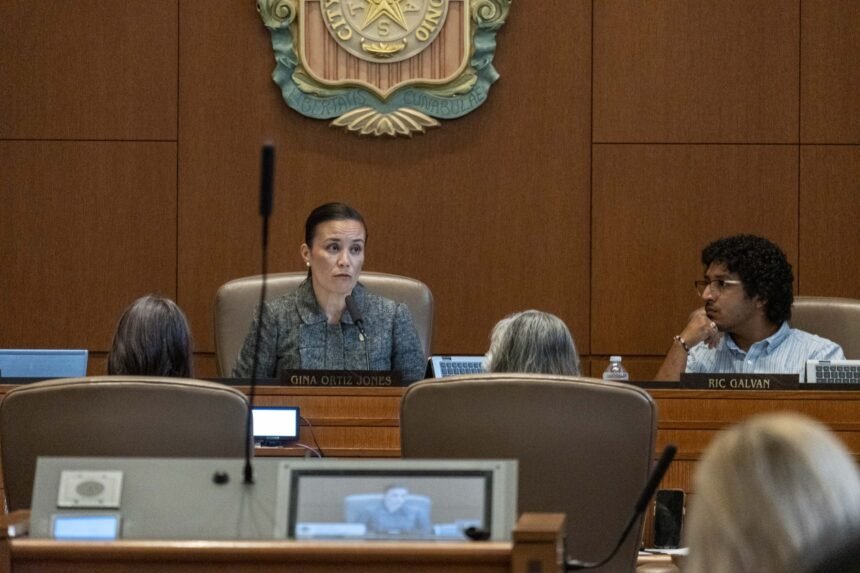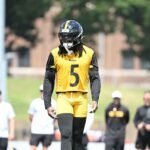San Antonio elected officials, city staff and residents spent over five hours on Friday debating how to pay for a new sports and entertainment district.
City officials said at a special City Council meeting they could contribute between $350 to $500 million to the project, which would be anchored by a $1.5 billion Spurs basketball arena.
Peter J. Holt, chairman and managing partner of the San Antonio Spurs, offered to pitch in $500 million for construction and $60 million in community incentives, while guaranteeing another $500 million through adjacent development — an investment of more than $1 billion.
City Manager Erik Walsh said plans for funding the project were preliminary, but the city could use a combination of leases in the project area and future tax and hotel revenues to pay back a city infrastructure bond for the project.
Last month, the city revealed that the proposed massive redevelopment project, known as Project Marvel, would include a $750 million expansion of the convention center, $100 million in improvements to the Alamodome, a new hotel tower and performing arts venue, as well as major infrastructure improvements.
Building the new sports and entertainment district in the Hemisfair area would require reconfiguring roads, establishing more parking, upgrading public transit and establishing a residential parking program for nearby neighborhoods.
Credit: Amber Esparza for the San Antonio Report
In a timeline presented to city council members, Walsh said the city would negotiate with the Spurs in the next week and present reports on the economic analysis and community engagement, before considering terms for an agreement on Aug. 21.
That date could be pushed back as officials work to get their questions answered.
Those negotiations kicked into a higher gear Thursday night, when Holt sent a letter proposing hundreds of millions of dollars in contributions.
Council members gave Walsh a list of questions they wanted the Spurs to answer. Mayor Gina Ortiz Jones proposed a revenue sharing agreement to help alleviate the city’s budget shortfall.
“We may see the cost of tickets increase and wouldn’t it be nice to get a cut?” she said. “I understand these are things that have not been traditionally discussed, but I think it’s important that we look at that.”
She noted the city’s funding needs for its general fund and for flood control projects. She also brought up workers’ pay in a press conference after the meeting as part of any agreement.
“We have an opportunity to think about what we put into this agreement in terms of living wages,” she said.
Walsh said the Spurs were unlikely to share revenue, given their $1 billion commitment outlined in Holt’s letter.
“Revenue sharing was not an option,” he said, but Jones did not back down from the idea.
The San Antonio Spurs did not comment on the possibility of revenue sharing.
Council members speak up
A new city council fresh from a June election seized their chance to dig into the issue.
Council members were divided on how much public support to lend the Spurs. Several council members urged Walsh to continue negotiations.
District 10’s Marc Whyte emerged as one of the city council’s pro-Spurs voices, calling for a partnership with the NBA team.
“The Spurs shouldn’t be the city piggy bank,” he said. “We shouldn’t be holding them hostage.”
Much of the council discussion, however, centered on a potential community benefits agreement, which could lay out conditions and rules for how the Spurs give back and work with the city if an arena does move forward.
Even council members who asked Walsh to move forward with the negotiation process and the financial structure outlined, like Phyllis Viagran (D-3) and Marina Alderete Gavito (D-4), wanted to keep an eye on communities’ basic needs.
Other council members were more skeptical about the city’s return on investment.
District 2 would lose the Spurs if they move downtown. The team has been playing on the East Side at what’s now called the Frost Bank Center since 2002.

Holt’s letter noted that a move downtown for the Spurs would allow continued success for community partners such as the San Antonio Stock Show and Rodeo, which “would gain the space and freedom they need to operate to their full potential.”
During the meeting, Jalen McKee-Rodriguez (D-2) asked for conditions like revenue sharing, ceasing games in Austin, including local housing and jobs guarantees and maintaining community oversight while calling for the team’s wealthy owners to contribute more in light of potential profits from a new arena.
“I would ask what those personal contributions would be,” he said. “Because there will certainly be personal gains.”
His skepticism was shared by District 5’s Teri Castillo and District 6’s Ric Galvan. Castillo said the Spurs could contribute more while Galvan said the Spurs had an opportunity to show their commitment to the community.
Where the city gets the money
Walsh said the city’s funding would eventually come from leases for the arena and surrounding development.
It would also come from future revenues, including the Hemisfair tax increment redevelopment zone, or TIRZ, which allows the city to use projected tax increases to fund development, and a project finance zone, which allows the city to access hotel associated revenues over a 30-year period.

Those would not, he emphasized, be money from the city’s general fund or routine expenditures.
Walsh said the city needs to iron out the community benefits promised by the Spurs.
Holt’s letter promised an estimated $60 million in community benefits in addition to $1 billion in funding, including setting space aside for locally-owned businesses, $35 million for early childhood education paid over 20 years and guaranteeing park-and-ride services for 2,000 attendees and making sure that 500 tickets are available for each game at $25 or less.
Walsh said city staff would pursue better understanding of the dollar amount as part of negotiations. Other major terms he listed as part of the negotiations were a promise from the team not to relocate, guarantees for property tax revenues from developers and that the Spurs take responsibility for designing, building and maintaining a new arena.
The funding proposals come after weeks of tight lips from the city and the Spurs regarding financing for an arena that could cost between $1.3 and $1.5 billion.
Bexar County officials have discussed providing $175 million to the new Spurs arena as part of an increase in the hotel occupancy tax. That increase would require voter approval during the November election if county officials ultimately decide to let that proposal go forward.
“It’s good news. One more piece of the puzzle that helps give the public insight on how the arena will be paid for,” said Jim Lefko, director of communications for Judge Peter Sakai. “Helps us move one step closer to calling for the venue tax election next month.”
Lefko added that the county’s exact number wouldn’t be finalized until the city and the Spurs clarify their contributions. Walsh’s presentation included the county’s contribution at more than $300 million, substantially more than the $175 million figure county officials had previously discussed.
Public commenters weigh in
Dozens of residents spoke at the meeting. Their arguments ranged from pro-development speakers who felt building the arena would benefit the local economy to advocates who argued the new arena shouldn’t even be built, private funding or not.
Leaders from multiple chambers of commerce said Project Marvel would ultimately benefit local businesses.

“It’s hard to make long-term decisions,” said Jeff Webster, CEO of the San Antonio Greater Chamber of Commerce. “This is an investment into the future.”
Other community organizations such as the Esperanza Peace and Justice Center and COPS/Metro argued against using public funds for the project.
“They need to take responsibility and pay for this arena if they want it,” said Fr. Jimmy Drennan, a pastor and longtime leader of COPS/Metro.
Other residents argued that basketball tickets were already too unaffordable and the city should focus on funding housing and infrastructure.
Public input was a sticking point for many city officials, who wanted to see a final economic impact analysis and a report on the city’s community engagement sessions to frame further negotiations.
The mayor praised the Spurs as representatives for the city, but added that residents had put forward concerns.
“We don’t do this every day. This is a generational investment,” Jones said after the meeting. “Now is the time to negotiate. Now is the time to get some answers to these questions.”













